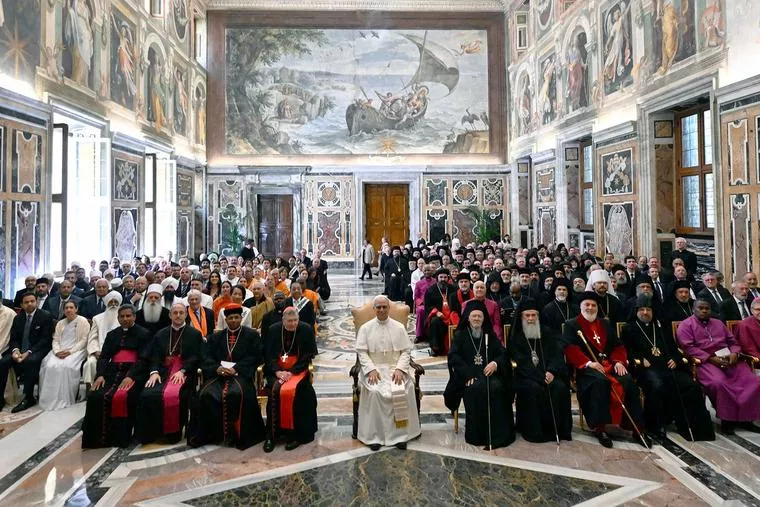
COMMENTARY: Rooted in the Rule of St. Augustine, Pope Leo XIV brings a communal and missionary spirit to the papacy — shaped by a lifelong formation in Augustinian life.
SIGN UP FOR OUR NEWSLETTER HERE
We have a Pope bound by a vow to live according to the Rule of St. Augustine. We have a Pope who is a brother of the Order of St. Augustine, a Pope who declared himself un figlio di Sant’Agostino — “a son of St. Augustine.”
Pope Leo XIV is, praise God, an Augustinian!
The Order of St. Augustine is one of the great mendicant orders of the Middle Ages, founded in 1244 when a group of canons and hermits were called to live together in communities first in Tuscany and then throughout the world. Known for their black habits with a long belt, they have tended to be overshadowed by the Dominicans and Franciscans. Some of their most famous members are St. Thomas of Villanova, St. Nicholas of Tolentino, St. Rita of Cascia, Gregor Mendel (founder of the study of genetics) and, alas, also Martin Luther.
But what might it mean that Pope Leo XIV is an Augustinian, a man shaped by his education at Villanova and by his formation in the order that aims to live as St. Augustine did?
While other orders follow the Rule of St. Augustine, none make it as central to their very meaning and existence. To understand Pope Leo XIV, it is worth looking at the Rule, a text he has read weekly since his novitiate, since, as Augustine writes, it “should be read to you once a week, so that you will see yourselves in this little book as in a mirror and not neglect anything through forgetfulness.”
Understanding the Rule can help us understand our new Pontiff and the task of his papacy, which is a task now shared by all the baptized.
Foundationally, the Rule calls the friars to “have one heart and soul living together towards God.” The Rule is a rule for pilgrims. For Augustine, the life of a Christian is a pilgrimage, with the Church as the “pilgrim City of God.”
Thus, as Pope Leo declared from the balcony, we must “all walk together toward that homeland which God has prepared for us.” What Augustine called his friars to live, he called all of us to live. And now Pope Leo summons us again to pilgrimage to God by living our “commitment to a daily journey of conversion.”
This life of conversion for an Augustinian is never alone. We are, for Augustine, “sharing our life together” and so we “live harmoniously in the house together.” An Augustinian spirituality is deeply and thoroughly communal. Friars live sharing everything in common and commit themselves to the common mission: “Let no one work for himself alone, “but all your work shall be for the common purpose.”
For the Augustinians, it is important that wherever they go “they go together” and wherever they stay, they “stay together.” There is no me without God for Augustine — and there is no me without us either. The twofold commandment of love of God and neighbor are fundamentally one. We must go to God together.
This, I think, is the importance of Leo’s repeated use of the word tutti, his proclaiming “peace to you all,” and his reminder that we need to build bridges among us and beyond us. Leo’s words are redolent of Catherine of Siena (a Dominican who lived according to the Rule and who sought spiritual counsel from an Augustinian hermit).
Pope Leo proclaimed that “humanity needs Christ as a bridge to reach to God and his love. Help us as well — help one another — to build bridges through dialogue, through encounter, uniting everyone to be one single people always in peace.”
The Church needs this summons to bring unity between progressives and traditionalists, between those who emphasize peace and justice and those who emphasize a culture of life, between celebrators of Vatican II and detractors, and between the vast regions of a global Church. This can only be done by living the words of Augustine, now the motto of Pope Leo: In illo Uno unum — “In the one Christ we are one.”
The Church also needs to build a bridge between itself and the world so that the world can cross over into the pilgrim City of God. As Augustinian Father Peter Donohue, the president of Villanova, noted, the “Augustinian charism is about building community.” This is the missionary heart of the Augustinians —drawing people by community into the community of God. They do this by loving those within and without the community. To be men of heart is always to broaden our heart out to others beyond the monastery, beyond our borders, beyond our Church to call them to live together with us toward God.
Such a form of life requires centering itself on the neediest. The Rule consistently calls for a preferential option for the needy. Friars are to “share all things in common” and give “to each in proportion to his need.” This is particularly important in helping those in the community who are weak. As Augustine taught, “love has the hands to help others. It has the feet to hasten to the poor and needy. It has eyes to see misery and want. It has the ears to hear the sighs and sorrows of men.” Leo XIV will hopefully follow this and his namesakes’ and predecessor’s example. Leo the Great welcomed refugees into Rome and put the Church at their service, Leo XIII was the pope of the poor and of workers, and Francis ever called us to serve those at the margins, especially the unborn and the refugee.
Finally, the Rule calls the brothers to be willing to correct each other when they go wrong and to live a life saturated with mercy. Augustine sees this as a united action, for we offer “love for the person and hatred for the sin.” The Rule sees the monastery as a field hospital (to borrow Pope Francis’ image) where the sickness is sin.
“If your brother had a bodily wound which he wished to conceal for fear of surgery, would not your silence be cruel and your disclosure merciful?” The Pope’s challenge is to offer such correction out of mercy. Thus if Leo is to live the Rule as Pope and to live like Leo the Great and Leo XIII, he will raise his prophetic voice against the oppression of workers, the rejection of migrants, the killing of the unborn, the distortion of the gift of the human sexuality, and the destruction of the planet. This correction is meant to set people back on the right path toward love of God and love of neighbor.
This ethos of loving correction must be shaped by mercy and forgiveness. The spiritual life for Augustine means knowing that in this life “our righteousness primarily lies in our repenting.”
God, as Augustine so often reminds us, forgives us, has mercy on us, if and only if we forgive others. Referring to the Lord’s Prayer, he tells his confreres, “If they have offended each other, they shall mutually forgive their offenses for the sake of your prayers.” The only person who does not belong in the monastery is the one who will neither seek forgiveness nor offer it. God, as Leo preaches to the world, “loves you all.” From that love, arises God’s merciful forgiveness in Christ and our vocation to merciful forgiveness of all.
It is that love that drove Augustinian Father Robert Prevost to Peru to serve those at the margins. It now sends him to Rome to serve from the center and, as he puts it, “to spend oneself to the utmost so that all may have the opportunity to know and love Christ.”
May that love and that Augustinian community vision shape his pontificate and the Church. And may St. Augustine and all the Augustinian saints pray for him and for us!
This article was originally published on National Catholic Register.
LIVE UPDATES: Pope Leo XIV’s first days

Terence Sweeney is an assistant teaching professor in the Honors Program and Humanities Department at Villanova University.







